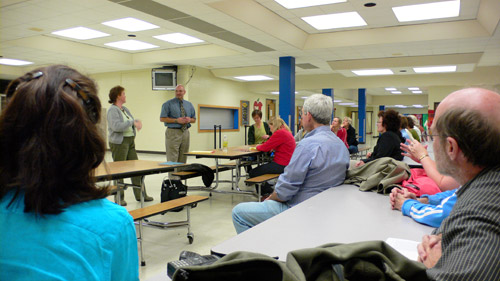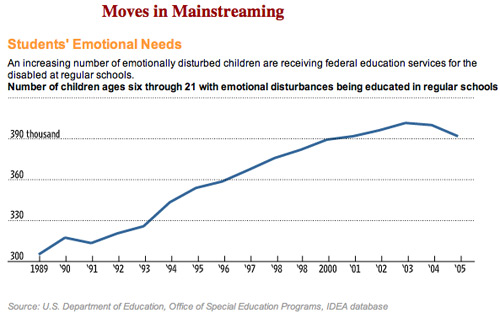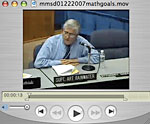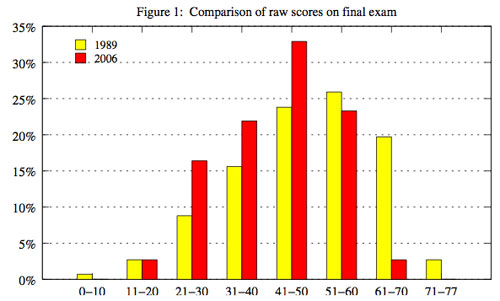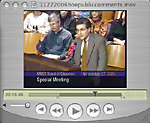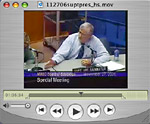Madison Superintendent Art Rainwater’s recent public announcement that he plans to retire in 2008 presents an opportunity to look back at previous searches as well as the K-12 climate during those events. Fortunately, thanks to Tim Berners-Lee’s World Wide Web, we can quickly lookup information from the recent past.
The Madison School District’s two most recent Superintendent hires were Cheryl Wilhoyte [Clusty] and Art Rainwater [Clusty]. Art came to Madison from Kansas City, a district which, under court order, dramatically increased spending by “throwing money at their schools”, according to Paul Ciotti:
In 1985 a federal district judge took partial control over the troubled Kansas City, Missouri, School District (KCMSD) on the grounds that it was an unconstitutionally segregated district with dilapidated facilities and students who performed poorly. In an effort to bring the district into compliance with his liberal interpretation of federal law, the judge ordered the state and district to spend nearly $2 billion over the next 12 years to build new schools, integrate classrooms, and bring student test scores up to national norms.
It didn’t work. When the judge, in March 1997, finally agreed to let the state stop making desegregation payments to the district after 1999, there was little to show for all the money spent. Although the students enjoyed perhaps the best school facilities in the country, the percentage of black students in the largely black district had continued to increase, black students’ achievement hadn’t improved at all, and the black-white achievement gap was unchanged.(1)
The situation in Kansas City was both a major embarrassment and an ideological setback for supporters of increased funding for public schools. From the beginning, the designers of the district’s desegregation and education plan openly touted it as a controlled experiment that, once and for all, would test two radically different philosophies of education. For decades critics of public schools had been saying, “You can’t solve educational problems by throwing money at them.” Educators and advocates of public schools, on the other hand, had always responded by saying, “No one’s ever tried.”
Cheryl Wilhoyte was hired, with the support of the two local dailies (Wisconsin State Journal, 9/30/1992: Search No Further & Cap Times Editorial, 9/21/1992: Wilhoyte Fits Madison) by a school board 4-3 vote. The District’s budget in 1992-1993 was $180,400,000 with local property taxes generating $151,200,00 of that amount. 14 years later, despite the 1993 imposition of state imposed annual school spending increase limits (“Revenue Caps“), the 2006 budget is $331,000,000. Dehli’s article mentions that the 1992-1993 School Board approved a 12.9% school property tax increase for that budget. An August, 1996 Capital Times editorial expressed puzzlement over terms of Cheryl Wilhoyte’s contract extension.
Art, the only applicant, was promoted from Acting Superintendent to Superintendent in January, 1999. Chris Murphy’s January, 1999 article includes this:
Since Wilhoyte’s departure, Rainwater has emerged as a popular interim successor. Late last year, School Board members received a set of surveys revealing broad support for a local superintendent as opposed to one hired from outside the district. More than 100 of the 661 respondents recommended hiring Rainwater.
Art was hired on a 7-0 vote but his contract was not as popular – approved on a 5-2 vote (Carol Carstensen, Calvin Williams, Deb Lawson, Joanne Elder and Juan Jose Lopez voted for it while Ray Allen and Ruth Robarts voted no). The contract was and is controversial, as Ruth Robarts wrote in September, 2004.
A February, 2004 Doug Erickson summary of Madison School Board member views of Art Rainwater’s tenure to date.
Quickly reading through a few of these articles, I found that the more things change, the more they stay the same:
- Pamela Cotant, in a September, 1992 article:
Hanson said the shortfall is partly due to about $1 million in underestimated expenditures. The largest of these are health, dental and othertypes of insurance costs that came in $300,000 over estimates; extended employment and extra duty costs, $300,000; and teacher salaries, $250,000.
In addition, the district did not receive as much as expected in areas suchas disabled tuition, Chapter I aid, food service income and interest income.
- Pam Cotant, writing in a May, 1991 article:
School board President Nan Brien also said the board and district are in a tough spot because so many programs have been cut to bring the budget proposal ($149M) under the cap.
“The cuts he made are going to give the board some real difficult times,”Brien said.
Brien said she was satisfied that Travis appeared to make his cuts across the board rather than in one area of the budget.
Travis cut $2.3 million in staff requests. Cuts include a phasing out of the birth to age 2 program for children with special needs and $86,000 in funding to the Bootstrap program for students at risk of not graduating.
Other cuts include 11 regular teachers and seven special education teachers, four positions in health services and about 10 custodial positions. Reductions also include $157,000 for a new child care program that would have helped students in the district’s School-Age Parenting Program, more than $35,000 for staff training and professional improvement, and $33,000 for an after-school program (AIMS) for minority students.
- December, 1992: Citizen / School Board call-in to discuss the then $180M budget by Gail Perry.
- April, 1999: Budget Cuts Likely for Madison Schools: Declining Enrollment and Special Ed Costs Blamed by Doug Erickson.
- Capital Times & Wisconsin State Journal archive searches (many articles):
- April, 1999 Wisconsin State Journal Editorial: Rainwater will Face Tough Choices
- October, 1992; Joyce Dehli’s Wisconsin State Journal article: Travis, Matthews: Schools’ New Boss Must Create Unity
- October 1994 Wisconsin State Journal Editorial: Either Back Wilhoyte or Fire Her
- School safety and spending were the topics of this September, 1992 article
- SIS comments on Art’s public retirement announcement
Fascinating. Perhaps someone will conduct a much more detailed review of the record, which would be rather useful over the next year or two.

